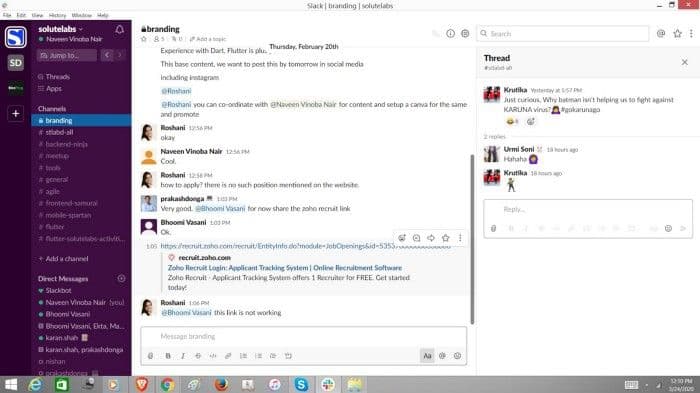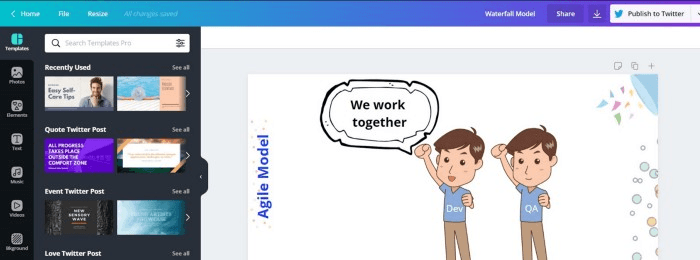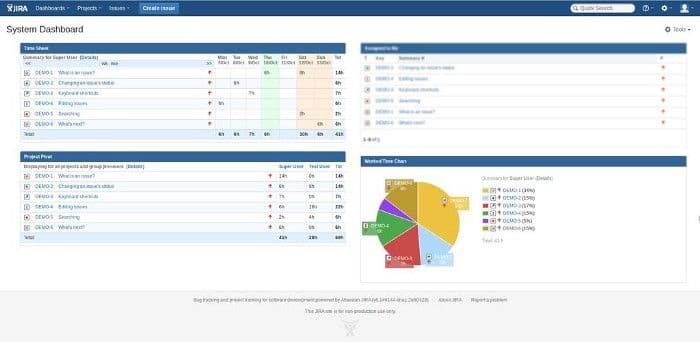For the first two months this year, we at SoluteLabs were looking for a Front End React JS Developer who would help us create cool looking websites. We found the perfect fit in Ronald, who joined us earlier this month.
The only catch? Ronald sits all the way in Uganda, which is a good 5000 kilometers from our office in Ahmedabad!!
A good onboarding process, proper communication tools, clear deliverables, and mutual understanding means Ronald is now kicking ass as a Developer in our team.
Welcome to the world of remote working. Here, the employees are spread around the globe, collaboration is done using the latest tools, and an office cubicle is a relic from ancient times.
Remote employees work from homes, cafes, subways, parks, basically any place with a WiFi and a place to plug in their laptop.
So is remote working the right way to go for your company?
Scroll down and get the answer to this question, along with other questions like:
- How did the remote working start?
- What are the pros and cons of hiring remote workers?
- What tools help you to manage your team remotely
- How does SoluteLabs handle its remote employees?
- Will remote working completely replace the traditional office structure in the future?
We have also peppered this piece with a few tips we learned while dealing with our own remote employees, along with interesting statistics that will surprise you.
For instance, did you know that according to a report by Flexjobs, there has been a 91% increase in the number of remote employees in the last ten years alone in the US?
Also, according to this survey, 99% of employees said they would like to work remotely at one point in their career or another?
Let’s begin with some interesting history first.
The evolution/history of remote working
If you look at history, remote working has always been around. From blacksmiths and carpenters to potters, before the Industrial Revolution, almost everyone worked out of their homes.
It was the Ford Motor Company that introduced the 40-hour workweek back in the 1920s, and other companies soon adapted this style of working.
Corporate headquarters, big office spaces, and cubicles soon followed suit, with Robert Probst designing the cubicle in 1968.
But as more and more employees started leaving their homes to sit and work in an office, there was a small group of thrifty individuals who wanted to get the work done from the comfort of their homes.
One of them was physicist Jack Nilles, a physicist who worked remotely on a NASA communication system. He published the Telecommunications-Transportation Tradeoff in 1973 and is considered the father of remote working.
The personal computer was introduced around this time, and by 1975, the first personal computers hit the scene.
In 1979, IBM became one of the first companies to allow a few employees to work from home as an experiment.
In the 80s and 90s, technology leapfrogged exponentially, with the introduction of the internet, Wi-Fi, and personal computers becoming more accessible to everyone.
JCPenney, the American conglomerate, allowed its call center employees to work from home as early as the mid-80s.
Working remotely was further boosted with the rise of co-working spaces, which were earlier termed hackerspaces. C- base, one of the first hackerspaces in the world, was founded in Berlin in 1995.
As the Millenium dawned upon us, almost 3.3 % of the total American workforce was working remotely.
Between 2000 and 2010, people who worked from home at least one day a week increased to 35%, according to this census report.
In 2010, US President Barack Obama signed the Telework Enhancement Act of 2010, which makes federal executive agencies to establish eligible employees to work remotely compulsory.
There has been a 44% growth in remote work over the last five years, and today, 4.3 million Americans work from home at least half the time.
As you see, remote working as a concept has come a full circle since the pre- Industrial revolution era and looks like it is here to stay
Pros and Cons of remote working
Remote working might seem like the perfect fit for some; others might shudder at the thought of never going to an office again. Here’s a quick rundown of things that we feel go for and against remote working.
A look at the Pros first.
Pros of Remote Working
Number 1: Flexibility
The number one reason most employees love the concept of working remotely is the freedom it provides in terms of flexibility.
Work sitting on the dinner table, on the couch, on the bed, at home, at a cafe, in the park, etc. etc.
In fact, according to this report by Flexjobs, 30% of 7300 respondents participating in a remote working survey said that they would leave a job if it did not offer flexible work options.
The ability to set your own timelines has been seen as a major reason why most employees prefer working remotely.
This flexibility also extends to your attire, where you no longer have to sit for prolonged hours of time in a stuffy suit that makes you sweat a lot.
Couple this with the option of not having to commute to a distant office every day and remote working definitely wins huge brownie points in this sphere.
Of course, there could still be challenges such as meetings with co-workers who have to be conducted during regular office hours, but this is just a small hiccup that many would happily accept.
Number 2: Money matters
A big advantage of working remotely is that the employees end up saving a lot of money. First and foremost, remote employees such as myself don’t have to be physically located in the same city as the company.
This means employees end up saving a large part of their salary spent on rent. According to Adhil Shetty, CEO of BankBazaar.com, “Ideally, you should not be spending more than 30% of your salary towards rent and utilities”.
Imagine saving this 30%, investing that amount instead of in mutual funds, a house in the suburbs, or your children’s education.
Remote employees are also saved from the ever-increasing transportation costs, which range from $2000 to as much as $5,000, according to a report by the US Bureau of Economic Analysis.
Other expenditures that are eliminated while working remote include money spent at the cafeteria, money used to buy an extensive wardrobe of work attire, etc.
Number 3: Health benefits
When working remotely, employees can spend more time preparing healthy snacks, eating at designated times, and adopting better health practices.
Less time spent commuting also means employees can spend that time instead of keeping their bodies fit, for instance, taking up meditation, yoga, or jogging.
Researchers have also found that spending prolonged hours in traffic affects psychological well being, stemming from the unpredictability that accompanies sitting in traffic.
Bottom line — remote working = better health for your employees.
Other than the benefits stated above, remote employees have also been found to be more productive and are less likely to leave an employer compared to someone who comes to the office.
Employers have benefits in hiring remote employees too. For instance, hiring remote means, you get access to the best available talent out there, irrespective of geographical boundaries.
Employers also need not invest money in expensive office infrastructure or arranging transport for your employees, which means additional dollars in the pocket.
Cons of Remote Working
Although the case for remote employees is strong, it does come with a few drawbacks such as:
1. Collaboration becomes difficult
Working remotely means there are high chances that your employees are working in silos, each completing their own tasks and not looking at the bigger picture.
Remote working does not give your employees a chance to brainstorm, which has been shown to produce creative solutions to problems.
According to John. J Murphy, author of Pulling Together: 10 Rules of High-Performance Teamwork, “ Behind every genius is a team. When people play off each other’s skills and knowledge, they can create solutions that are practical and useful.”
When your employees are sitting in different locations, it is difficult to get them to work as a team, and, as a result, you may be missing out on great ideas.
2. Miscommunication
With distributed teams, it is easy to lose track of communication, leading to a lot of back and forth emails, long and winding Slack threads, and, in general, a waste of time.
According to this report, approximately 90% of a message’s meaning is conveyed by bodily and social cues, such as tone, eye- contact, and context, rather than the words used. Unsurprisingly, most of it is lost through email.
Add to this the fact that at large companies, employees are sending more than 200 Slack messages per week, according to a Time is Ltd., a productivity- analytics company. This means for most employees, keeping up with Slack messages seems like a full-time job.
Communication breakdown is a common issue with most remote employees, with many feeling that they are left in the dark when it comes to important team decisions.
At the end of the day, you don’t want your employees to work in silos, and definitely don’t want them to feel left out.
3. Accountability
One of the obvious reasons people love to work remotely is that they don’t have to deal with pesky co-workers, who seem to be working all the time. While remote working can put an end to unnecessary office gossip and lost productivity time, there is also a flip side to this coin.
While working at an office, people work, or at least make a conscious effort to work because:
a. They see other people around them working.
b. These other people around them can know when they are slacking off.

When working remotely, there is no social office environment, which means there is no one to nudge you to get the work done. This means you will have to be your own taskmaster, which, for those who lack self-discipline, can be an arduous task.
These are the only few hiccups that employees face when working remotely, and, with better adoption of technology, they can be easily overcome.
5 Must-have online collaboration tools to manage remote teams efficiently
Here at Solutelabs, we manage more than half a dozen remote workers and recommend the following tools to get you up and running, setting up a remote team.
1. JIRA- For Project Management
Solutelabs uses JIRA for all its Project Management needs. JIRA has the advantage that it combines visual workflows, dashboards, a wide array of integrations and add-ons to customize and simplify our project.
Since we use Agile to develop most of our software, JIRA fits right into our technology stack, and we use it extensively in our daily standups.
The six-core parts of the Sprint that we use JIRA to manage are:
1)Sprint 2)Backlog 3)\Story 4)Epic 5)Bug 6)Task.
JIRA provides a framework using which we can develop different features. The project is divided into broad epics, which continue across sprints.
Epics are further divided into stories and stories into tasks, with each task being assigned status such as “In Progress” and “Done.”
JIRA greatly helps us streamline the Agile Development process, and is a great tool to visualize the current status of a project.
2. Slack — For Communication
Like a majority of distributed, mid-sized IT firms, we at SoluteLabs use Slack for all our day to day communication needs.
Slack is super easy to use, intuitive, fast, and they keep pushing out a new feature every other month, which makes us one of its biggest advocates.

We use Slack to discuss everything ranging from critical project updates to throwing surprise birthday parties.
Slack is super easy to set up on the mobile, too, making it the preferred app among our employees for all internal communication.
Pro Tip: When using Slack, if there is a conversation where you need to take action on multiple steps of the thread, use the “Remind me about this” feature that pops up when you click the three dots next to the message.
We at SoluteLabs have found that this feature prevents us from forgetting critical parts of the conversation on Slack.
3. Zoom — for Video Calling
Being a remote-friendly organization with employees distributed across continents, we use video calls extensively to stay connected, and Zoom is our preferred video calling tool.
Zoom also lets us record the calls, including chats, so that we have a backup of the conversation, which we can use later while writing our reports.
Zoom is super easy to set up, and you can be up and running in a few clicks, which makes it user friendly if our employees are using Windows or Mac.
4. Pipedrive — For sales
Although our sales team here at SoluteLabs is relatively new and consists of only two members, we have made sure that they have all the tools at their disposal to make their life easy.
Pipedrive is a tool that our sales team extensively uses to manage all their day to day activities.
With Pipedrive, our sales reps can save all the information of a lead/ company with details such as contact name, address, email id, mobile number, etc.
Pipedrive also allows our reps to save a draft of the outreach email that they are going to use, with the option of being able to customize it at a later stage.
Pipedrive also allows you to record the call logs and reminds us to send follow up emails with notifications that can be configured to pop up at dates/ times that are predefined by us.
The ongoing transaction that your sales rep is pursuing is tracked in the form of a deal, which continues throughout the stages of your pipeline till your deal is either “Won” or “Lost.”
Deals help you track all the movements and events throughout the sales process.
5. Canva - For design
Any list for collaborative tools used by SoluteLabs is incomplete without our personal easy to learn Photoshop — Canva.
Canva is extensively used by the marketing team at SoluteLabs to create Linkedin banners, Facebook posts, infographics, etc. In other words, anything that requires the skill level of a novice but needs to look like a visual designer did it.

Canva is an excellent tool for collaboration, and here at SoluteLabs, we usually have more than one person working on a design, selecting fonts, etc. These elements go into any visual that appears on the SoluteLabs blog or social media channels.
Pro Tip: Canva has a huge variety of ready to use Instagram post templates. We use these to save time and also to give our Instagram posts a professional look.
6. ProofHub
ProofHub is an all-in-one project management and team collaboration tool that brings everything a team needs to keep track of their tasks, projects, clients, and communications in one place. It makes it easier for teams to handle their daily tasks and projects, whether they are working remotely or in the same office.
How SoluteLabs manages remote employees
A good initiation program, constant communication, clear deliverables, and a sense of ownership, these are the cornerstones of SoluteLabs’ remote employee policy.
These policies help us to get the maximum output out of our remote employees, while also assuring that they feel connected to the company like a regular employee.
We have written a separate post on how to build a culture in a remote-friendly workplace, which you can check out here-
Let us take a look at these policies in detail:
Initiation: The first few days at an organization are crucial for both the employer and an employee. An employee forms long term impressions about the company in the first two or three weeks, and the employer can judge if the employee is a good fit for the organization.
At SoluteLabs, we make sure that the employee gets a good initial grasp of the organization by making them physically present at our office in Ahmedabad.

We make sure that the employee is made to feel at home the first day by having a dedicated desk assigned to them, along with a small welcome kit, which includes a custom-made T-shirt.
We also assign an onboarding buddy to our new joinee, who is a senior SoluteLabs employee. This onboarding buddy introduces the new joinee to the rest of the team, explains which team member is responsible for what function.
Once the new joinee spends a few days at our base location, they are free to move on to the preferred city from where they would like to work. The initiation period acts as a good ice breaker and ensures that the newbie knows the key players in the team, with whom they would be collaborating.
No collaboration is possible without a proper communication tool, which brings us to the next section.
Constant Communication: Our remote employees are encouraged from their early days to communicate any issue they have with the team members openly.
These issues can range from project deliverables to negotiating deadlines, any issue the remote employee feels he needs more clarity on.
We ensure that every remote employee has at least one voice call with the rest of the team every day, where they are expected to discuss what they plan to achieve over the course of the day.
This status update call is usually scheduled around the beginning of their workday, and, if they need to work on any other task that might arise during the day, they are expected to convey the same over Slack.
With daily zoom calls and intermittent Slack updates, we make sure our remote employees always feel “connected” to the organization.
What do these daily status calls contain? This brings us to an important cornerstone of our remote employee policy, clear deliverables.
Clear deliverables: Every remote employee at SoluteLabs has a clear set of deliverables that are established during their initial days.
These deliverables can range from a blog post a week for the content writer to one JIRA task a day for a developer.
According to Nishan Bende, a developer who has been working remotely for close to 2 years now, having clear deliverables greatly helps them manage their day to day activities.
“Every day, I analyze the storyboard with my team members in the earlier part of the day. I then sort the tasks by priority and start working on the most important task. This way, both the team and I get to know what we are expected to achieve for that particular day.”
Having clearly defined deliverables helps our remote team stay on track, and instills a sense of accountability in them.
The future of remote working
Remote working is not just a passing fad. As we dig deeper to find out where remote working is headed in the future, there are clear indications to show that more and more companies around the world are encouraging remote employees.
For instance, the city of San Antonio in the US has asked all the employers in the area to authorize flexible hours, encourage four day work weeks and reduce their commute to improve the air quality levels.
As co-working spaces become more popular, more and more offices in the US are moving towards renting spaces in these co-working spaces or smaller offices.
In fact, according to this study, only 55% of all workstations are used on an average workday. This would lead offices to rent out their additional space to other businesses to manage their operational costs.
Data will also play a key role in helping firms understand employee behavior and how they interact with the office environment.
Co-working spaces will also further evolve into co-living spaces, appealing to the GenZ and millennial workers by providing them a communal living and working space. WeLive, a subsidiary of WeWork, is already opening communal living spaces in New York.
Virtual Reality and Augmented Reality will also play a key role in the office spaces of the future. Calling colleagues for a meeting from home could be further enhanced using business VR headsets to see all of your teammates in the living room.
Remote working does seem to be catching on rapidly, and we may see a greater percentage of remote workers in the future. But will it replace the traditional office structure? Highly unlikely since a lot of our day to day activities will always involve a one on one interaction.
What do you think? Share your thoughts in the comments section below or tell us on any of these platforms- Twitter, Facebook, Instagram, or LinkedIn.
















